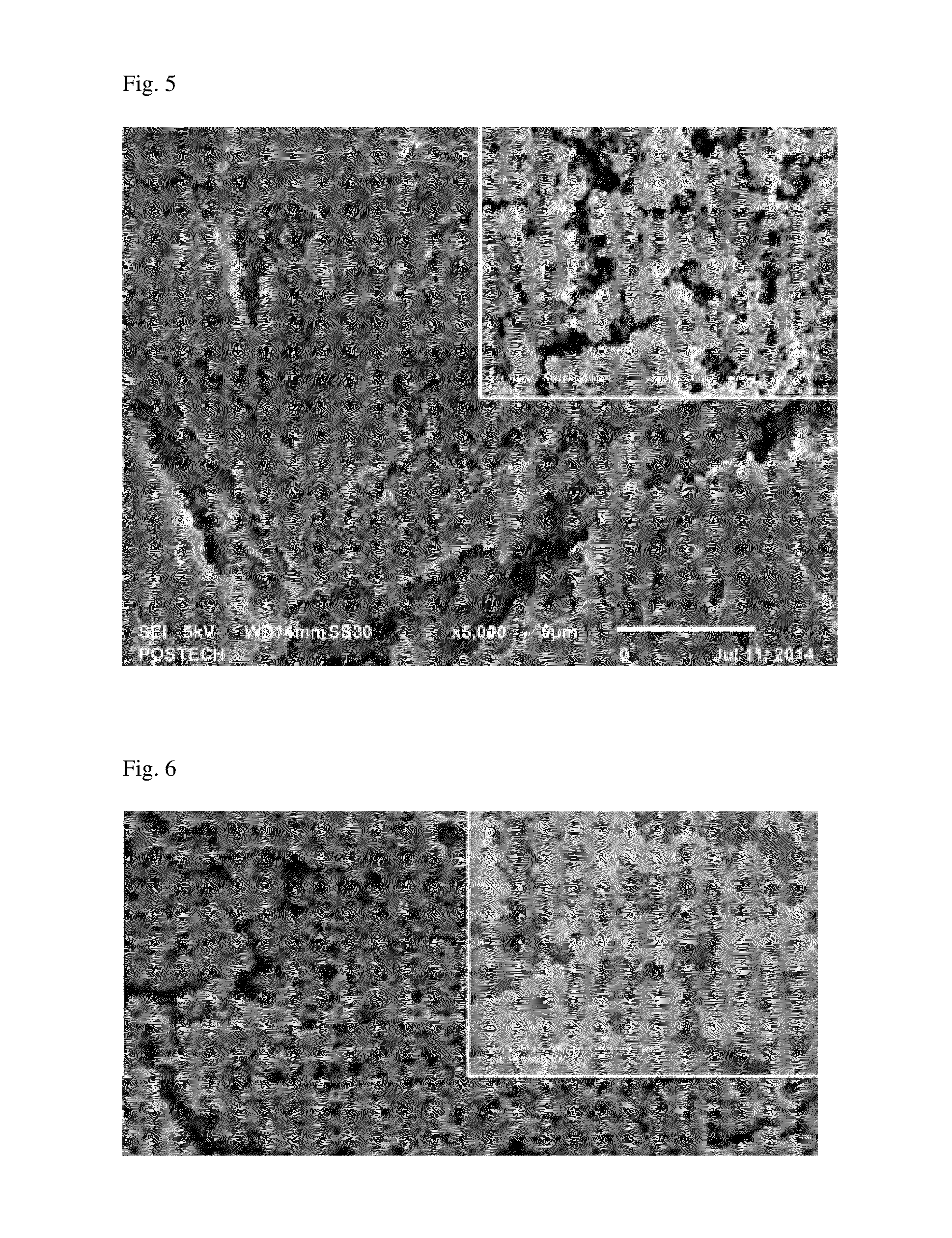Mussel-inspired bioactive surface coating composition generating silica nanoparticles
a bioactive surface coating and mussel technology, applied in the direction of peptide/protein ingredients, prosthesis, peptide sources, etc., can solve the problems of many restrictions in the industrial application of the naturally extracted mussel adhesive protein, potent toxic risk, and inability to meet the requirements of in vivo environments, and achieve excellent adhesion strength of the mussel adhesive. , the effect of promoting cell proliferation or differentiation
- Summary
- Abstract
- Description
- Claims
- Application Information
AI Technical Summary
Benefits of technology
Problems solved by technology
Method used
Image
Examples
example 1
Preparation of Fusion Protein
[0066]Primers (Table 3) for a silica-binding peptide sequence derived from the diatoms C. fusiformis were constructed. These primers were used to perform polymerase chain reaction, thereby preparing a fusion protein, in which the silica-binding peptide was linked to a mussel adhesive protein, fp-1 (SEQ ID NO. 1) or fp-151 (SEQ ID NO. 3).
TABLE 3 SEQ IDNO.PrimerNucleotide sequence (5′→3′)8ForwardGCGCCATATGAGCAGCAAAAAATCTGGCTCCTATTfor R5CAGGCTCGAAAGGTTCTAAACGTCGCATTCTGGGTGGCGGAGGGGCGAAACCGAGCTATCCGCCGACC9ReverseGCGCCTCGAGCTTGTACGTTGGAGGATAAGAAGGfor MAP
[0067]As in FIG. 3 showing the schematic illustration of fusion protein (R5-MAP) construction, an R5 peptide (SEQ ID NO. 5; SSKKSGSYSGSKGSKRRIL) was linked to a mussel adhesive protein (MAP), such as mussel adhesive protein fp-1 or fp-151. A pET-22b(+) vector containing T7 promoter was used as a plasmid vector, and transformed into an E. coli TOP10 strain. Further, for expression of the fusion protein, the clo...
example 2
Preparation of Fusion Protein-Silica Nanoparticle Complex
[0070]2-1: Use of Polymer Substrate Surface
[0071]To coat the surface of a coverslip made of polystyrene with the fusion protein-silica nanoparticle complex, 5% acetic acid solution containing 5 mg / ml of the fusion protein prepared in Example 1 was applied to the substrate surface, and left at room temperature for 12 hours to perform protein deposition. In this regard, to remove the fusion proteins which were not properly adhered to the surface, the substrate surface was washed with distilled water so as to obtain a fusion protein(R5-MAP)-coated substrate surface.
[0072]The fusion protein-coated substrate surface was immersed in 1 M trimethylorthosilicate (TMOS) solution for 2 minutes so as to prepare a complex, in which the silica nanoparticles were linked to the fusion protein. To remove silica which was not properly adhered to the substrate surface, the substrate surface was washed with distilled water.
[0073]To confirm format...
example 3
In Vitro Cell Test of Surface Coating Composition
[0082]3-1: Cell Culture by Use of Surface Coating Composition
[0083]A cell function-improving ability of the bioactive surface coating composition including the fusion protein-silica nanoparticle complex of Example 2 was examined in vitro.
[0084]In the same manner as in Example 2-1, four types of the coated substrate surfaces were prepared by coating the surface of the polystyrene coverslip. In detail, the four types of the coated substrate surfaces include 1) the surface of polystyrene coverslip (NC) which was coated with none of the fusion protein and TMOS, 2) the surface (Si—NC) which was coated with TMOS, but without R5-MAP fusion protein, 3) the surface (R5-MAP) which was coated without TMOS, but with R5-MAP fusion protein, and 4) the surface (Si-R5-MAP) which was coated with R5-MAP fusion protein-silica nanoparticle complex formed after treatment of TMOS solution.
[0085]5×104 mouse osteoblast MC3T3-E1 cells were cultured on the fou...
PUM
| Property | Measurement | Unit |
|---|---|---|
| Adhesivity | aaaaa | aaaaa |
| Cell proliferation rate | aaaaa | aaaaa |
Abstract
Description
Claims
Application Information
 Login to View More
Login to View More - R&D
- Intellectual Property
- Life Sciences
- Materials
- Tech Scout
- Unparalleled Data Quality
- Higher Quality Content
- 60% Fewer Hallucinations
Browse by: Latest US Patents, China's latest patents, Technical Efficacy Thesaurus, Application Domain, Technology Topic, Popular Technical Reports.
© 2025 PatSnap. All rights reserved.Legal|Privacy policy|Modern Slavery Act Transparency Statement|Sitemap|About US| Contact US: help@patsnap.com



